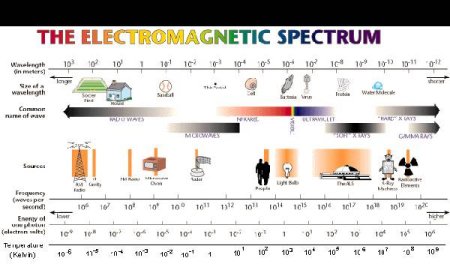


Surrounded by waves
Televisions, radios, microwave ovens, and torches, what do all of these have in common? Well they all rely on electromagnetic waves in order to operate. The signals sent from television and radio stations to the television and radio in your home are sent as electromagnetic waves, microwave ovens, as their name suggests use microwaves, a type of electromagnetic wave, to cook your food, and finally torches emit light, which is an electromagnetic wave. As you can see we are indeed surrounded by electromagnetic waves, or electromagnetic radiation.
What is an Electromagnetic wave?
An electromagnetic wave consists of two components, a magnetic one and an electric part. These two components oscillate orthogonal to one another and travel in the direction of wave propagation. All electromagnetic waves travel at the same speed of 186,000 miles per second, or 300,000,000 (3 x 108) ms-1 and can propagate through a vacuum i.e. they do not require a medium to propagate through like sound waves for example.
Although all electromagnetic waves travel at the same speed they do exhibit various properties, X-rays can penetrate through certain materials like human skin for example. The reason that different waves can exhibit different properties is because their wavelengths (or frequencies) are different. The relationship between the wavelength, frequency and speed of an electromagnetic wave is given by:c = v 
Where c is the speed of light, v is the frequency, and  is the wavelength.
is the wavelength.
The Electromagnetic spectrum
With the knowledge that electromagnetic waves can have varying wavelengths and frequencies, the electromagnetic spectrum can then be defined as the continuum of all electromagnetic waves, from radio waves with the longest wavelengths to Gamma rays with the shortest wavelengths.
Terms such as radio wave, X-ray and gamma ray have been used in the explanation of the electromagnetic spectrum so far but what do they mean? Well although the electromagnetic spectrum has no real hard boundaries it is convenient for us to split it into various regions in order to be able to explain the properties exhibited by the waves in these various regions. The spectrum is split into the following regions:

Click image for a larger version
This image shows all of the regions in the electromagnetic spectrum and gives examples of objects equivalent in size to the wavelength of the waves at points along the spectrum
REGION | WAVELENGTH RANGE |
Radio wave | 105m - 10-3m |
Microwave | 3x10-1m - 10-3m |
Ultraviolet | 10-3m - 7x10-7m |
Optical | 7x10-7m - 4x10-7m |
Infrared | 4x10-7m - 10-9m |
X-ray | 10-8m - 10-11m |
Gamma ray | < 10-11m |
![]()
next page

